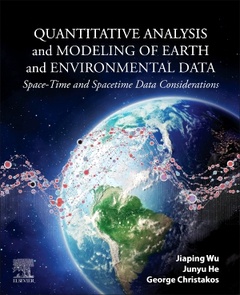Quantitative Analysis and Modeling of Earth and Environmental Data Space-Time and Spacetime Data Considerations
Auteurs : Wu Jiaping, He Junyu, Christakos George

Quantitative Analysis and Modeling of Earth and Environmental Data: Space-Time and Spacetime Data Considerations introduces the notion of chronotopologic data analysis that offers a systematic, quantitative analysis of multi-sourced data and provides information about the spatial distribution and temporal dynamics of natural attributes (physical, biological, health, social). It includes models and techniques for handling data that may vary by space and/or time, and aims to improve understanding of the physical laws of change underlying the available numerical datasets, while taking into consideration the in-situ uncertainties and relevant measurement errors (conceptual, technical, computational). It considers the synthesis of scientific theory-based methods (stochastic modeling, modern geostatistics) and data-driven techniques (machine learning, artificial neural networks) so that their individual strengths are combined by acting symbiotically and complementing each other.
The notions and methods presented in Quantitative Analysis and Modeling of Earth and Environmental Data: Space-Time and Spacetime Data Considerations cover a wide range of data in various forms and sources, including hard measurements, soft observations, secondary information and auxiliary variables (ground-level measurements, satellite observations, scientific instruments and records, protocols and surveys, empirical models and charts). Including real-world practical applications as well as practice exercises, this book is a comprehensive step-by-step tutorial of theory-based and data-driven techniques that will help students and researchers master data analysis and modeling in earth and environmental sciences (including environmental health and human exposure applications).
1. Introduction to Concepts2. Data Classification, Characterization and Collection3. Statistical Modeling4. Geostatistical Modeling5. Variography6. Regional and Chrono-regional Estimators7. Krigology8. Bayesian Maximum Entropy9. Software Tutorials
Appendix1. Probability and Random Variable Theory2. Instructor and Student Resources
Graduate students in Earth and Environmental Science, Geography, GIS, and data analysis; GIS scientists, Earth Scientists, geographers
Junyu He is Professor at the Institute of Island and Coastal Ecosystems at Ocean College,Zhejiang University. His research interests include geostatistics, environmental modeling, and risk analysis. His PhD dissertation was specifically on quantitative analysis and modeling of data with spatial variation and temporal dynamics.
George Christakos is a Professor in the Department of Geography at San Diego State University (USA) and in the Institute of Island & Coastal Ecosystems, Ocean College at Zhejiang University (China). He is an expert in spatiotemporal random field modeling of natural systems, and his teaching and research focus on the integrative analysis of natural phenomena; spatiotemporal random field theory; uncertainty assessment; pollution monitoring and control; human exposure risk and environmental health; space-time statistics and geostatistics.
- Explores the analysis and processing of chronotopologic (i.e., space-time and spacetime) data that varies spatially and/or temporally, which is the case with the majority of data in scientific and engineering disciplines
- Studies the synthesis of scientific theory and empirical evidence (in its various forms) that offers a mathematically rigorous and physically meaningful assessment of real-world phenomena
- Covers a wide range of data describing a variety of attributes characterizing physical phenomena and systems including earth, ocean and atmospheric variables, environmental and ecological parameters, population health states, disease indicators, and social and economic characteristics
- Includes case studies and practice exercises at the end of each chapter for both real-world applications and deeper understanding of the concepts presented
Date de parution : 12-2021
Ouvrage de 502 p.
19x23.3 cm
Thèmes de Quantitative Analysis and Modeling of Earth and... :
Mots-clés :
Analytic statements; ANN; Attribute data scales; Backtransformation; BIC; Big data; Biological neural network; BME; CGRD; CGS; Chronos; Chronotopologic; Chronotopologic block data analysis; Chronotopology; Classical geostatistics; Cogency; Contingogram; Covariance modeling; Covariography; CTDA; CTI; Data-intensive analysis; DIA; DRT; Empirical; Epistemology; Gaussian; Geographic distance; Geostatistics; GICTM; HFRS; ICTM; Interpolation; Knowledge; Kriging; Land use regression; Machine learning; Methodologic chain; Multiple linear regression; PDE; Random field theory; S/TRF; SEIR; Simple linear regression; Spacetime; SPDE; Standard distance; Statistics; STIK; STOK; STP; Sysketogram; Topos; Variogram; Variogram features; Variography; Worldtube



